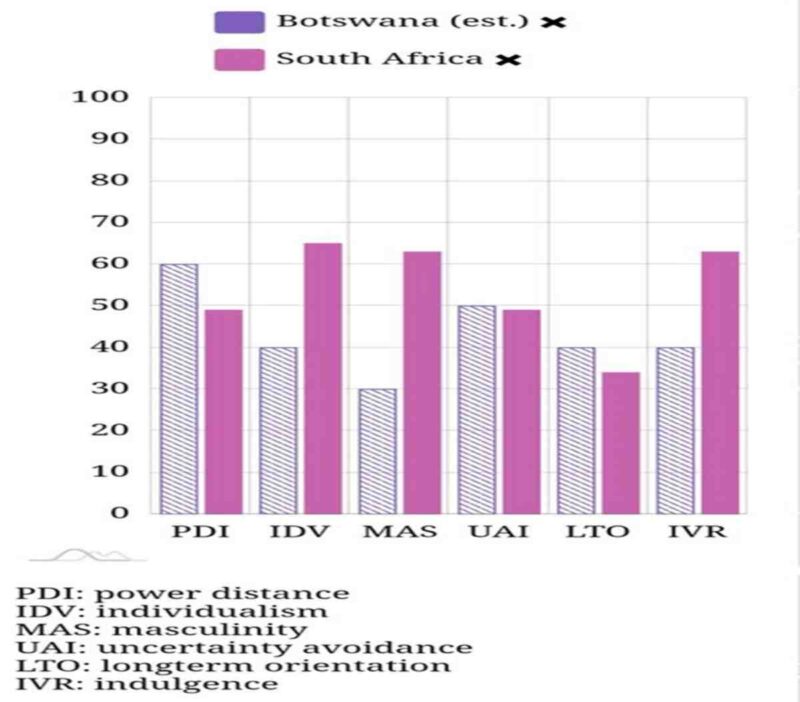How Black-Diamonds Destroy South Africa
Executive Summary
When adjusted for purchasing power parity (PPP), Botswana’s GDP per capita is $18k, whereas South Africa’s is only $14k. South Africa does not perform economically as well as Botswana does because children under nine years are raised differently compared to Botswana. This disparity perpetuates itself because black-diamonds in South Africa do not take collective moral responsibility for the education of the young of the group, only their own young, while in Botswana, there are firstly no black-diamonds and secondly, their leaders do take that responsibility collectively.
Beginning in the mid-1990s, South Africa’s geopolitical, social and economic landscapes have been rapidly transforming. Driven primarily by government policy particularly after 1994, these changes have among other effects offered tailor-made opportunities to the educated and resourceful black South Africans (so-called ‘black diamonds’) in the townships to rise on the socio-economic ladder. The main question this research paper attempts to answer is why only some of black middle-class township dwellers (black diamonds or BDs) do not relocate to former whites-only suburbs?
Comparative Analysis Using Hofstede’s Cultural Index
Comparing the cultural indexes and dimensions of South Africa with Botswana provides significant insights regarding the economic performances of both countries, particularly South Africa. The tool used for this analysis is the Hofstede Cultural Index, and also available on its website is where country comparisons can be performed. The resulting graph from this comparison below is essential to understanding the underlying cultural factors.
Enduring Cultural Indexes
The primary point to understand is that these indexes endure across generations because young children learn from their parents. This intergenerational transmission of cultural values plays a critical role in shaping the economic and social fabric of a nation.
Research and Insights
The evaluation of the cultural indexes from South Africa and Botswana, starts by eliminating similarities while trying to understand the bigger differences. However, it is important to also understand the meaning of the similar indexes because it provides a backdrop for the other more scrutinized indexes.
The similar indexes (also called dimensions) are the following:
- PDI is Power Distance Index (lower-classes accept superior hierarchy)
- UAI is Uncertainty Avoidance (acceptance if score is <50))
- LTO is Longterm Orientation (short-term if score <50)
The Power Distance Index is not important between the two nations compared, but it is very important to understand that a high score indicate that “power” is more important than morals and laws, also that the lower classes accept a superior hierarchy which means the lower classes accept “inequality.”
That SA and Botswana are similar with a score around fifty therefore “in-between,” is on its own an entire subject for research. Lastly, evaluating PDI and UAI together means that both SA and Botswana are “in-between” a real “market economy” and a “controlled hierarchy economy.” In practise this means that the middle-class is severely limited, but more importantly, municipalities and the retail-sector are dead in the water.
The dissimilar indexes (also called dimensions) are the following:
- IDV is Individualism (Collectivism if score <50)
- MAS is Masculinity (Femininity if score <50)
- IVR is Indulgence (Restraint if score <50)
South Africa appears to be Individualistic and Botswana Collectivistic, where one explanation might be that the survey was done on university students that would be more oriented towards individualism due to performance requirements. When a different metric such as Matriarchal vs Patriarchal society surveys is done, it may show that both Nations favour collective cultures equally, especially either from a rural perspective or from a tribal perspective. In fact, it is highly likely that most Sub-Saharan Nations exhibit a Collective orientation.
As far as Masculinity/Femininity is concerned, the two countries differ substantially again, and again it may be because surveys focussed on university students where females are not proportional since money is controlled by men and women is required (by their mothers) to do work at their rural homes. In urban settings cultural traditions may be negatively affected because there is no land to cultivate and no cattle to herd. (Matriarchs decide how many children to have and what they will work at)
The remaining index is the Indulgence/Restraint index that finally provide substance as to why the two countries differ so much in economics (GDP/capita above). Indulgence describes those peoples that perceive to have control over their lives (leaders/black-diamonds), while Restraint peoples perceive themselves happy to work, and whatever happens to them won’t be their own doing (they don’t take moral responsibility, which is like saying plausible deniability)
In other words, there is almost a class difference in this index, where the lower class are quite willing to accept the hierarchy and the hierarchy’s instructions, in exchange for the upper class to “look out” and to “look after” them, taking responsibility in effect. Everything is fine if leaders and black-diamonds tell the workers what to do – instructions they are quite comfortable waiting for.
It is almost the same between parents and their children, where children are comfortable with parents’ instructions. But there is a big difference with schools and schoolteachers who are not in the upper class. Parents don’t want to help their own children to do school homework, and they expect the “school” to – just like the Elite – tell the kids what to do, help them with homework and give them food, if not accommodation too. The South Africa Government tried the ABET initiative which failed the youth but is successful with senior literacy in general. The latest attempt by Ramaphosa to improve youth education via the Bana Pele Initiative is also destined to fail.
The divide between the leaders/black-diamonds and workers can best be described by saying that leaders/black-diamonds are not concerned with work or the morality of it, while the workers are concerned with work because they do the work, but leaders/black-diamonds must accept the moral responsibility, which of course, they don’t e.g., protests about service deliveries are just blamed on somebody else, such as municipal councillors, whom are also not seen as upper class and therefore “just doing their job” for which they don’t have to take moral responsibility.
One practical case also demonstrating this was when, as the ANC Youth League representative, Julius Malema correctly put the moral blame on the ANC for its lack of “economic freedom” due to cadre deployment policies. They fired him but then realised that to keep him at arm’s length would enable them to keep the workless busy with mobilization (previously a Union responsibility).
Combining both Indulgence and Longterm Indexes together provides further interesting insight. South Africa has (and Botswana not) the unenviable characteristic of being overly Indulgent AND being Short-term oriented which is bad for economics. And the more indulgent they get the more short-term society becomes.
Another characteristic worth mentioning is that these Elites do not experience crime, causing them to reduce Governmental police and military capability (security cluster), resulting in increased crime and lawlessness at the working-class level. Exposure to increasing criminal behaviours has a life-long effect on young children, but they normalise it and will pass that on to the next generation, also further disenfranchising emergency services.
Other researchers using the Hofstede model include South African Johannes Cronje, who has contributed to the understanding of how cultural indexes impact various aspects of societal development. The insights derived from these studies highlight the importance of cultural factors in economic performance and the need for targeted educational reforms to address these issues.
Summary:
- Cultural indexes are applicable across generations and are therefore a reliable basis to argue from.
- Cultural indexes are best used in country comparisons, not alone, unless other methodologies are applied as back up, such as separate cultural studies/surveys or technically oriented studies like MunicipalIQ.
- South Africa does not perform economically like Botswana does because children <9y are raised incorrectly as compared to Botswana and it perpetuates itself because the leaders, driven by black diamonds in South Africa do not take moral responsibility for that collective education, while in Botswana they do.
Conclusion and Recommendations
In conclusion, the differences in economic performance between South Africa and Botswana can be largely attributed to the abovementioned cultural dimensions, specifically the approach to early childhood exposure at home. South Africa’s economic decline is caused and perpetuated by bad education, which in turn is primarily caused by parents teaching their own children the same they were taught at home, because they refuse to do it differently thinking it is the “school’s” job. This means that Botswana parents raise their young children better than parents in South Africa, which is mostly driven by the black-diamond Vulture Culture.
In South Africa’s Vulture Culture, scavengers – domestic and foreign – seem to hold the upper hand, ripping the skin from the body politic.
The liberal right-of-centre coalition that took power in 2024 alienated citizens with its austerity and repressive crime-fighting tactics, giving way in 2029 to a fragile populist coalition. The new coalition government embraced an authoritarian populism at odds with the constitution, lashing out at critics and journalists, denigrating migrants, and seemingly working with criminal syndicates. The spoils of office and the budgets of SOEs are carved up and served to the connected.
Addressing these cultural and educational disparities is crucial for improving South Africa’s economic performance and ensuring a more equitable and prosperous future for its children.
It is recommended that a comparative survey of parents with small children in both countries be performed, across all classes.
It is also recommended that comparative surveys of South African and Botswana municipalities and third-level Governments are performed across all disciplines.
Tags: black diamonds, botswana, middle classes, south africa, vulture culture










